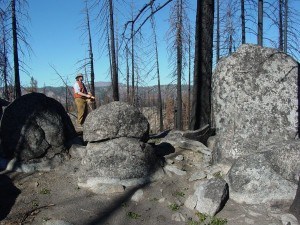When it comes to forest fires, the weather matters.
Over a 35-year period, the length of forest fire seasons worldwide increased by 18.7 percent due to more rain-free days and hotter temperatures, according to South Dakota State University professor Mark Cochrane, a senior scientist at the Geospatial Sciences Center of Excellence. The wildfire expert is part of a team of researchers led by W. Matt Jolly of the U.S. Forest Service Fire Science Laboratory that examined weather data from 1979 through 2013 to determine how a changing climate impacts forest ecosystems. Their findings were published in Nature Communications.

“For things to burn, they have to have the proper conditions,” he explained. Four independent environmental factors increase the likelihood of wildfires—hotter temperatures, decreased relative humidity, more rain-free days and higher wind speeds.
The researchers combined fire danger indexes from the United States, Canada and Australia with three global climate databases to create what Cochrane calls “an ensemble model.” They looked at the length of time and areas where conditions were conducive to fires.
“Ecosystems are designed to withstand the normal climate situation, but we suspect that things aren’t normal anymore,” Cochrane said.
On all the forested continents, except Australia, the fire seasons are getting longer, Cochrane explained. South America had the largest increase—33 days in 35 years. In addition, the area affected by the longer fire season has doubled.
To verify their model, the researchers pinpointed time intervals and areas where fire danger was highest.
“All the major fire events showed up in our metrics,” he said, including forest fires in the Amazon rainforest in 2005, Western Russia in 2011 and Spain in 2012. “That lends credence to the model and gives us confidence that the model is showing real changes that relate to physical factors.”
The researchers found that the number of rain-free days has increased by 1.31 days per decade. The average temperature on vegetated land increased by 0.185 degrees per decade, while the annual relative humidity dropped by 0.127 percent per decade. “Our values are very conservative,” Cochrane added.
However, the mean annual precipitation worldwide is the same, according to Cochrane. “It’s still the same amount of rainfall, just concentrated in fewer days.” That translates to more dry days when conditions are amenable to burning.
The United States has experienced hotter, drier weather in six of the last 10 years, he pointed out. During that time, the nation has spent more than $1.7 billion on wildfire suppression.
Source: South Dakota State University
Was this article valuable?
Here are more articles you may enjoy.

 UPS, FedEx Scramble to Shore Up Networks Drained by Deadly Crash
UPS, FedEx Scramble to Shore Up Networks Drained by Deadly Crash  ‘Super Roofs’ Are Rewarding Insurers, Cat Bond Investors and Homeowners
‘Super Roofs’ Are Rewarding Insurers, Cat Bond Investors and Homeowners  RBC Denies Claims of ‘Boys Club’ Culture, Bias Against Women
RBC Denies Claims of ‘Boys Club’ Culture, Bias Against Women  Supreme Court Questions $1 Billion Music Piracy Suit Against Cox
Supreme Court Questions $1 Billion Music Piracy Suit Against Cox 